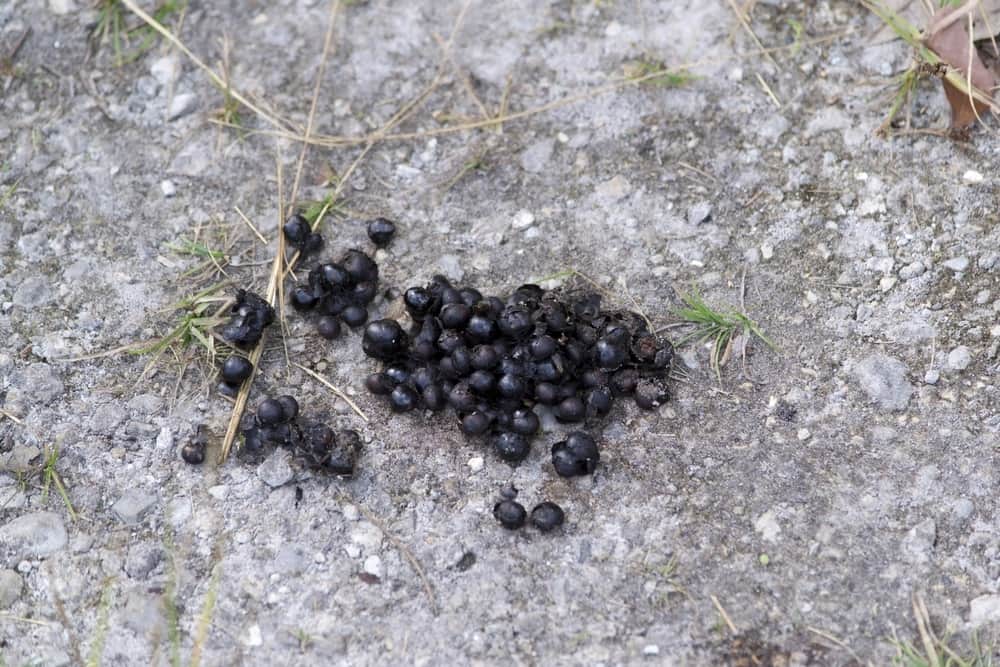
Raccoons are known to sometimes carry pathogens that may cause disease, but did you know that many of these pathogens are actually carried in their feces? Raccoon feces are usually about two to three inches long, dark and tubular in shape. An easy way to tell dog feces from raccoon poop is to look for undigested food. Raccoon feces often contains pieces of undigested berries that can be easily seen.
Raccoons establish community latrines, which are sites where they repeatedly deposit droppings on top of old feces in one particular area. And since raccoons tend to be social animals that live in small communities for protection, the latrines are often quite large and easy to find.
As mentioned before, raccoon feces can carry pathogens that may cause disease. One of the biggest health risks is raccoon roundworms, which is also called Bayliscacaris procyonis. According to research by the University of Georgia, it can be difficult to diagnose, especially if the physician does not know about a past exposure to raccoon feces.
The Centers for Disease Control and Prevention says that Baylisascaris procyonis is a roundworm that can be harmful, even fatal to people. The roundworm eggs are passed in the feces of infected raccoons, and people can become infected by ingesting or even inhaling the eggs.
Once the eggs have entered into the body, they hatch into larvae that then move to different parts of the body. This can cause illness in a short amount of time. The University of Georgia says that symptoms of infection in humans can include:
• Nausea
• Liver enlargement
• Loss of coordination
• Loss of muscle control
• Blindness
Canine distemper is another disease that's associated with raccoons and their droppings. Both cats and dogs are vulnerable to it, especially if they have not been vaccinated against it. If you have pets, consult with your veterinarian about vaccinations.
HOW TO HELP KEEP RACCOONS OFF OF YOUR PROPERTY
It is important to protect yourself if you think you may have raccoons on your property. To do this, remove or tightly secure any potential outside food sources, if possible, that might attract raccoons. This includes pet food, garbage cans or bird feeders. Raccoons are notorious for getting into these while looking for food at night, typically due to their ability to use their paws to open items.You should also try to remove any water sources that a raccoon could find overnight.
Also make sure to never feed raccoons or bring them into your home. Make sure to close off any potential access points to attics, crawl spaces or basements. Also, if you know raccoons frequent your property, always wash your hands after working outside in the dirt so you do not accidentally carry or ingest any potential roundworm eggs or bacteria.
New York City’s Public Health website says that anyone who has come into contact with or may have ingested raccoon feces should immediately contact a health care provider to help prevent further infection. And if someone has symptoms of raccoon roundworms, he or she should seek immediate medical care.
SHOULD YOU TRY TO REMOVE RACCOON FECES YOURSELF?
It's not recommended to try to remove raccoon feces yourself. There are too many risks of exposure to dangerous diseases and bacteria if not removed professionally and you could potentially stir up microbes that can be inhaled.
It's also important that you do not try to remove raccoons, or any other nuisance wildlife animal, on your own. Although removing the raccoon, or other nuisance wildlife animal, responsible for the droppings will be the first step towards removing the droppings, this is also best left to a professional as there are potential consequences with DIY nuisance wildlife control.
If you have raccoons in your home, or spot signs of raccoon activity, then the nuisance wildlife control professionals at Terminix should inspect your property and help you get rid of them.




